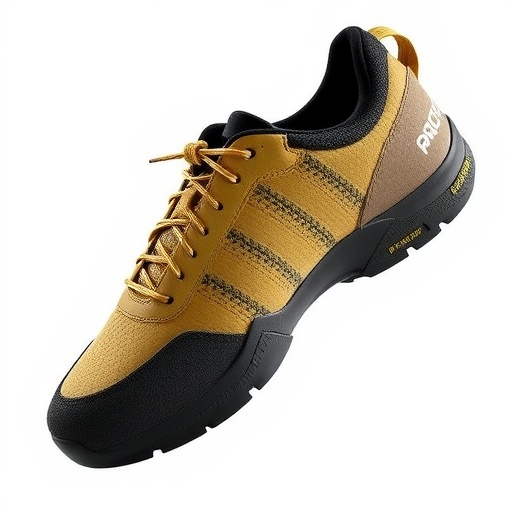In a groundbreaking study, researchers Elkington, Armitage, and Khan have delved into the intricate world of climbing shoe rubber, revealing significant insights that could influence the design and performance of climbing footwear. This research, published in the journal Sports Engineering, shines a light on the tribological properties of climbing shoe rubber, a key factor that directly affects the performance of climbers in a variety of conditions. The findings indicate a direct correlation between rubber composition and climbing effectiveness, prompting the climbing community to re-examine the materials used in their favorite gear.
Tribology, the study of friction, wear, and lubrication, plays a crucial role in understanding how rubber interacts with climbing surfaces. Climbers often face varying conditions and surfaces, from smooth rock faces to textured artificial walls. The rubber on climbing shoes must provide not only grip but also durability. This study meticulously examines the performance characteristics of different rubber formulations, aiming to identify which combinations offer the best balance between stickiness and longevity.
One of the standout aspects of the research is its approach to measuring the coefficient of friction, which plays an essential role in a climber’s ability to ascend smoothly. The researchers employed advanced testing methods to conduct controlled experiments, simulating real-world climbing scenarios. Through these tests, they gathered data on how different rubber types respond under various conditions. The meticulous methodology employed showcases a comprehensive understanding of the fundamental principles of material science, which are instrumental in enhancing climbing shoe technology.
The researchers discovered that softer rubber typically offers greater friction on smoother surfaces, while harder rubber provides better durability and support. This revelation leads to practical implications for climbers seeking to choose the right shoes for specific climbing environments. With an array of climbing styles—ranging from sport climbing to bouldering—the choice of rubber can significantly influence a climber’s success and confidence on the wall.
The implications of the study extend beyond mere performance enhancements. The findings may push manufacturers to innovate and redesign climbing shoe rubber compositions. As climbing continues to gain popularity, especially within high-performance athletic communities, the importance of technology transfer—where innovations in material science find practical applications in sports gear—cannot be overstated. Manufacturers may begin experimenting with new blends and compounds inspired by the study’s findings, leading to potentially revolutionary advancements in the industry.
Furthermore, the research presents valuable guidance on shoe maintenance and care. Climbers have long debated the best ways to maintain the grip of their shoes. The study suggests that understanding the properties of climbing rubber could empower climbers to better preserve their gear. This aspect of the research could revolutionize climbing shoe care practices and extend the lifecycle of climbing footwear, saving athletes money and resources in the long run.
An equally essential issue identified in the study is the environmental impact of rubber production. With sustainable practices gaining traction across various industries, the findings shed light on the potential for developing eco-friendly rubber alternatives. As climbers become more conscious of their ecological footprint, manufacturers who invest in sustainable materials may find themselves leading the market. The intersection of performance, sustainability, and innovation represents an exciting frontier in the climbing world.
Moreover, the study is not only relevant to climbers but also to those engaged in other sports where grip is paramount, such as parkour and trail running. The rubber characteristics analyzed can be translated across different sporting applications, revealing the broader impact of this research. The interconnectedness of climbing gear and other athletic equipment opens doors for collaborative innovations, fostering a culture of shared knowledge and advancements.
As the climbing community eagerly anticipates advancements in climbing shoe technology, this research provides an exciting glimpse into the future. Climbers may soon find themselves equipped with shoes engineered with cutting-edge rubber formulations that enhance their performance. Whether battling steep rock faces or tackling tough routes indoors, the potential for improved gripping power via optimized rubber selections heightens the excitement for upcoming climbing competitions.
In a world where athletes constantly push their limits, the importance of investing in high-quality equipment tailored to enhance performance cannot be overstated. The collaboration between researchers and manufacturers is vital in ensuring that climbers and other athletes can rely on gear that meets their evolving needs. As new insights emerge from studies like this, the landscape of climbing gear will continue to shift, encouraging athletes to reach new heights.
As this pioneering work begins to impact the climbing footwear market, it is essential for athletes to remain informed and engaged. The conversation surrounding footwear technology is becoming increasingly relevant, as athletes advocate for shoes that not only support their performance but also contribute to the longevity and sustainability of the sport. The climbing community is likely to experience a shift in consumer preferences as this information empowers climbers to make informed purchasing decisions.
Ultimately, Elkington, Armitage, and Khan’s study serves as a pivotal contribution to the world of climbing and sports engineering. By illuminating the properties of climbing shoe rubber and their impact on performance, the researchers have laid a foundation for future advancements in climbing gear. Athletes, manufacturers, and sports enthusiasts alike will benefit from the knowledge generated within this research, paving the way for innovations that will define the future of climbing technology.
Through continued exploration and dedicated research, the climbing community can anticipate a future where each ascent is enhanced by the synergy of cutting-edge materials science and the relentless spirit of adventure that defines the sport. The journey of understanding and improving climbing footwear is just beginning, and this study is a vital stepping stone on that path.
Subject of Research: Climbing shoe rubber and its tribological properties.
Article Title: Sticky feet: a tribological study of climbing shoe rubber.
Article References:
Elkington, R.J., Armitage, J.L., Khan, T. et al. Sticky feet: a tribological study of climbing shoe rubber. Sports Eng 27, 30 (2024). https://doi.org/10.1007/s12283-024-00474-4
Image Credits: AI Generated
DOI:
Keywords: Climbing shoes, tribology, rubber composition, climbing performance, material science, sustainability.




